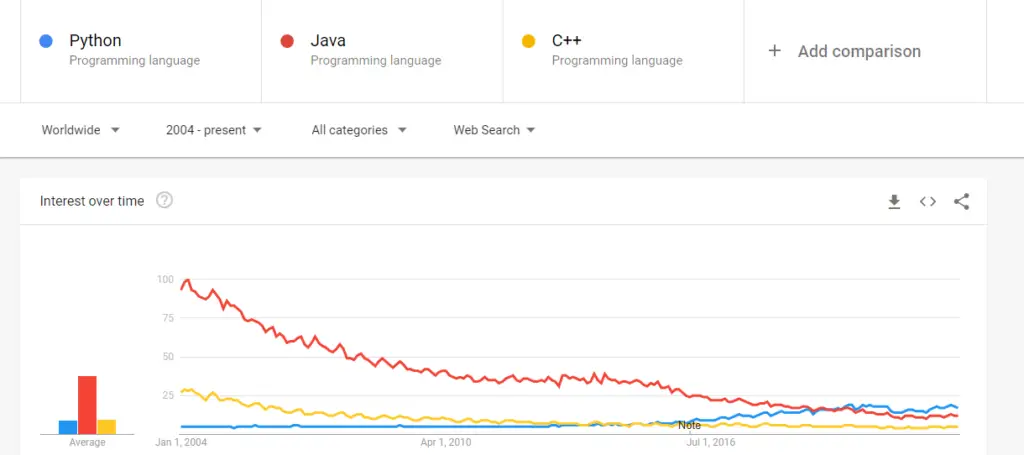Python is the most extensively used multi-purpose, high-level programming language at the moment that is well-known for its broad usefulness. Because of its accessibility and similarity to the English language, Python might be an excellent coding language for absolute beginners.
Being an easy-to-learn tool, Python can also be scaled up and applied for enormous, difficult tasks such as compiling massive quantities of data and conducting machine learning algorithms. Python is the technology of the future, and it can do almost all sorts of things.
In this article, let’s look at the future scope of Python and the opportunities available in the field of Python. Let’s dive right in.
Scope of Python in the Upcoming Future
There are many reasons why Python is here to stay, and it will be the programming language of the future. Let’s understand why Python has a bright future ahead.
Python Has Plenty of Use Cases
Python is gradually becoming the preferred language of choice for aspiring programmers who want to master it and get a development job. Python is extremely versatile. As previously said, Python is a multifunctional language that may be used for a variety of purposes.
Python is popular for web development, data science, web scraping, automation, etc. It is also used in cybersecurity, blockchain, mobile application development, desktop application development, and many other fields.
You can use Python for executing basic tasks as well as highly complex applications, such as analyzing enormous quantities of data.
The Popularity of Python Is Increasing Steadily
Python is one of the most popular programming languages at the moment, and people prefer it because of its simplicity and versatility. Python is a programming language suitable for everybody, from corporate software developers to casual coders.
While the popularity of the Python language has grown over the previous few decades, the popularity of some other languages such as Java and C++ has been steadily declining. Take a look at the following data from Google Trends that represents changes in the popularity of Python, Java, and C++ over the last few decades.

More and more enterprise businesses are moving ahead with Python nowadays. Python has also grown its roots deep in the educational system, implying that it is on its way to becoming the best programming language for students. Most universities around the world prefer Python as the introductory programming language for teaching students.
Python Is the Preferred Language for AI and Data Science
Data science and AI (artificial intelligence) are relatively young topics still in the early stages of development. Python is the top choice here, which means it isn’t going away anytime soon, just as these new fields aren’t going away. Data science will be drawing the masses to Python in the future.
The relevance of data science is increasing day by day, and as a result, Python is also booming quite a lot. The availability of data science packages like Numpy, Pandas, Matplotlib, etc., makes Python the go-to programming language for data scientists.
Python has a substantial user base in the industry for both computation and building data libraries. Python makes it easy to implement machine learning, which aids in the refinement of algorithm-based technology (for example, speech recognition, product suggestion, etc.).
Python is also preferred for processing and mining massive data, which has a lot of use cases in several industries. It is not an exaggeration to claim that data science and Python will have the finest jobs in the future, complementing each other and propelling them to new heights.

Artificial intelligence has a lot to do in many fields, including modern medical science. AI can help cancer research and diagnosis of many diseases at an early stage. AI can do a better job than humans in many cases by analyzing various factors about the disease and patients.
The use of technologies like machine learning can immediately enhance the capacity of researchers and medical experts to anticipate treatment outcomes more precisely than ever before.
There is no unique programming language devoted to AI, but by examining the properties of each language that can handle AI, they may select Python as it is one of the most reliable and popular programming languages for machine learning.
Developments and Inventions Will Frequently Happen in Python
The open-source approach will promote plenty of experiments and inventions using Python. While many other languages are produced and maintained by a single firm, Python is usable and distributable for free, even for commercial use. There is a wide range of options for Python developers.
Python does not require large expenditures in either time or infrastructure. You can start small, build your application, and test your products faster. If it makes sense, you can scale the application to the next level using Python itself. This makes it a suitable language for start-ups.
The simplicity in writing code, faster development time, availability of libraries and modules to help you do almost any tasks, etc., are some features that make Python the perfect choice for modern developers. At the same time, Python also gives you the flexibility to scale up your application to any level.
Advantages of Python
Here are a handful of Python’s major advantages:
| Simple syntax | Python features an easy-to-learn syntax and makes use of English terms. |
| Readability | Python code lines are also simple to read. Python, for example, instead of semicolons or parentheses, employs a clean way of code indentation to finish a task. |
| Popularity and accessibility | Python has a large community of users and supporters, which helps to keep it accessible to people of all skill levels. It is also free and open-source. |
| Scalability | Python is scalable, and it allows you to start building the application without worrying about any scalability issues. |
Python has certain limitations as well. For example, the execution time of Python is sometimes slower because of its line-by-line execution approach. However, its benefits make it an appealing option for modern programmers.
Final Thoughts
Software developers need to migrate slowly into the future, and adopting more Python is a way to do that. The question is how to do it carefully and with a solid strategy.
We are going to see continuous growth in the scientific programming part of Python. So things that support the performance of Python as a language and its stability are going to continue to evolve.
Beyond that, Python is a pretty powerful and solid language. We live in a data-driven world, and we’re setting Python up for another few decades of success and growth.
I hope this article was helpful. Let me know your thoughts in the comments section. Happy coding!

